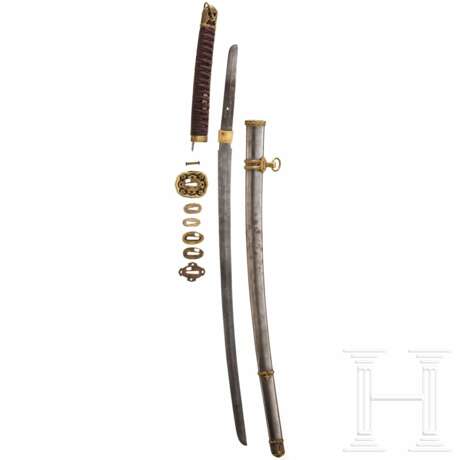ID 1106890
Lot 9132 | Sammlung aus Teilen der Replik eines Shin Gunto, China, Ende 20. Jhdt.
Estimate value
€ 100
A uniform ensemble for an officer of the infantry of the Imperial Japanese Army, Taisho period
Visor cap for officers of black wool cloth trimmed with golden flat cord, lacquered front visor, on the forehead an embossed gilt sun symbol, chinstrap of patent leather on darkened buttons with blossom in relief, black silk lining with label "K. Imai & Co., Osaka", sweatband of black patent leather. Comes with a white and red feather plume in a separate cardboard case. Double-breasted uniform tunic of black wool cloth with gold buttons (blossom motif), red piping, red cuffs with gold braiding, the collar embroidered in gold, black stitched cloth lining (label "K. Imai & Co., Osaka"), inside breast pocket. Also a pair of trousers of black wool cloth with red lateral stripes. Two braided golden shoulder boards in a wooden box. Furthermore, a golden sword knot, a grey leather hanger with gilt fittings (blue cloth lining with moth holes), a pair of white leather gloves and a white linen band (somewhat stained, length 90 cm) with sewn-on red sun symbol.
Comes with a letter in Japanese language, which locates the owner of this uniform in Manchuria according to the consignor. In the original carrying case (dimensions 75 x 50 x 20 cm). Also a Kyu-gunto ("Type 19 Company Grade Kyu-gunto" according to J. Dawson, , Swords of Imperial Japan, p. 64) with wooden dummy blade, brass knuckle-bow hilt, ray skin grip and scabbard with field-type leather cover (rubbed, leather torn at the top), length 81 cm. Slightly damaged in places, traces of age. Very representative and in beautiful state of preservation.
Condition: II
| Address of auction |
Hermann Historica Bretonischer Ring 3 85630 Grasbrunn / München Germany | ||||||||||||||
|---|---|---|---|---|---|---|---|---|---|---|---|---|---|---|---|
| Preview |
| ||||||||||||||
| Phone | +49 (0)89 5472 649 0 | ||||||||||||||
| Fax | +49 (0)89 5472 64999 | ||||||||||||||
| Buyer Premium | 25 % | ||||||||||||||
| Conditions of purchase | Conditions of purchase | ||||||||||||||
| Business hours | Business hours
|



